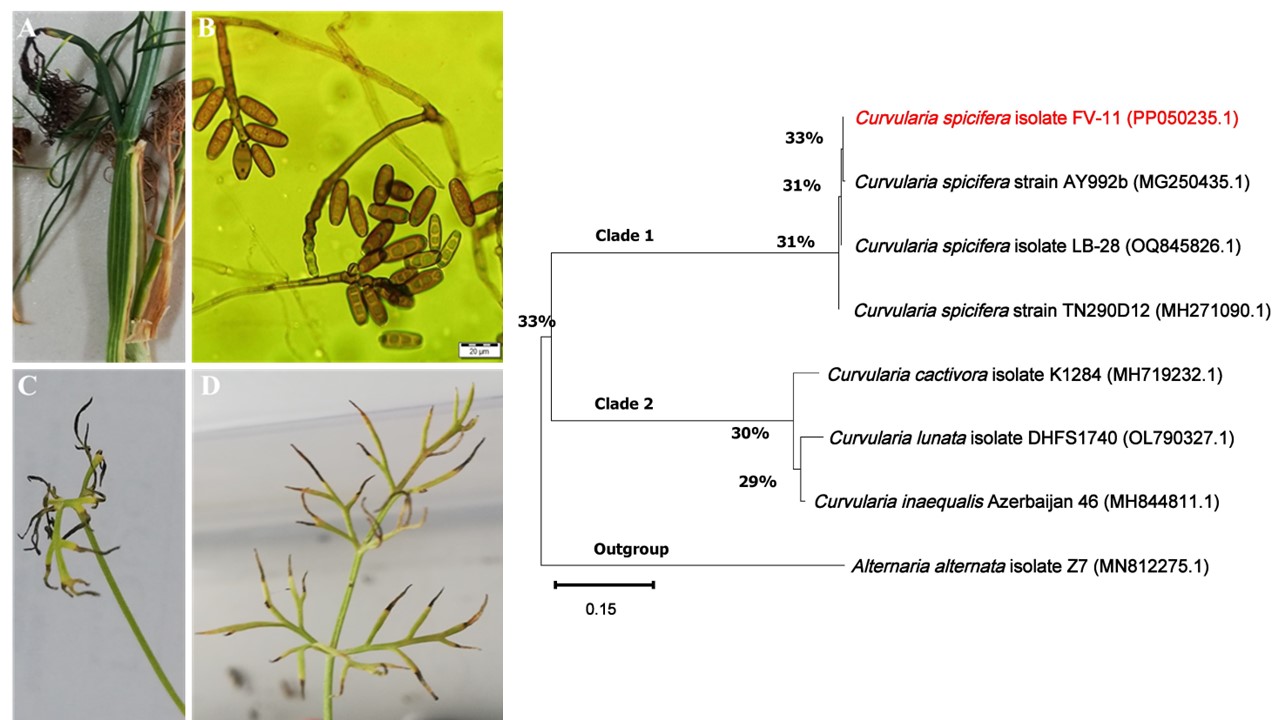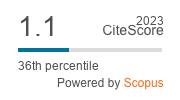Identification of Curvularia spicifera causing foliage blight on Foeniculum vulgare
DOI:
https://doi.org/10.55779/nsb16211966Keywords:
Curvularia spicifera, fennel, foliage blight, ITS-rDNA, pathogenicityAbstract
Curvularia is an important genus that contains plant pathogenic species that are found all over the world and have a broad host range. Fennel (Foeniculum vulgare) is a cultivated plant and has been commonly used as a traditional food and medicine. During August 2021, severe foliage blight symptoms were observed on fennel grown in Isparta province, Türkiye. The causal organism of this foliage blight was isolated from diseased tissues and identified as Curvularia spicifera, based on characteristics of morphology. The fungal isolate's morphological identification was confirmed through phylogenetic analysis of the internal transcribed spacer region (ITS) of the rDNA gene sequence. Pathogenicity to fennel was confirmed through inoculations of healthy plants. To our knowledge, this is the first report of C. spicifera causing foliage blight on fennel in Türkiye and worldwide.
Metrics
References
Ahmed R, Aslam MN, Moosa A, Shakeel MT, Maqsood A (2023). First report of leaf spot of Aloe vera caused by Curvularia spicifera in Pakistan. Journal of Plant Pathology 105:1193. https://doi.org/10.1007/s42161-023-01396-z
Aiello D, Vitale A, Polizzi G, Voglmayr H (2020). Ochraceocephala foeniculi gen. et sp. nov., a new pathogen causing crown rot of fennel in Italy. MycoKeys 66:1-22. https://doi.org/10.3897/mycokeys.66.48389
Amaradasa BS, Amundsen K (2014). First report of Curvularia inaequalis and Bipolaris spicifera causing leaf blight of buffalograss in Nebraska. Plant Disease 98(2):279. https://doi.org/10.1094/PDIS-05-13-0487-PDN
Aslam HMU, Ali S, Atiq M, Mansha MZ, Aatif HM, Anwaar HA, Naveed K (2020). First report of brown leaf spot of rice caused by Curvularia spicifera in Pakistan. Journal of Plant Pathology 102:939-940. https://doi.org/10.1007/s42161-020-00517-2
Ayoubi N, Soleimani MJ, Zare S, Zafari D (2017). First report of Curvularia inaequalis and C. spicifera causing leaf blight and fruit rot of strawberry in Iran. Nova Hedwigia 105(1-2):75-85. https://doi.org/10.1127/nova_hedwigia/2017/0402
Badgujar SB, Patel VV, Bandivdekar AH (2014). Foeniculum vulgare Mill: A Review of its botany, phytochemistry, pharmacology, contemporary application, and toxicology. BioMed Research International 2014:842674 https://doi.org/10.1155/2014/842674
Bessadat N, Hamon B, Bataillé-Simoneau N, Hamini-Kadar N, Kihal M, Simoneau P (2023). Identification and characterization of fungi associated with leaf spot/blight and melting-out of turfgrass in Algeria. Phytopathologia Mediterranea 62(1):73-93. https://doi.org/10.36253/phyto-14169
Brown SP, Rigdon-Huss AR, Jumpponen A (2014). Analyses of ITS and LSU gene regions provide congruent results on fungal community responses. Fungal Ecology 9:65-68. https://doi.org/10.1016/j.funeco.2014.02.002
Cui WL, Lu XQ, Bian JY, Qi XL, Li DW, Huang L (2020). Curvularia spicifera and Curvularia muehlenbeckiae causing leaf blight on Cunninghamia lanceolata. Plant Pathology 69(6):1139-1147. https://doi.org/10.1111/ppa.13198
El Mhadri M, Benkirane R, Ouazzani Touhami A, Douira A (2009). Citrullus lanatus, a new host of Bipolaris spicifera in Morocco. Phytopathologia Mediterranea 48(2):291-293. https://www.jstor.org/stable/26463354
Ennaffah B, Ouazzani Touhami A, Douira A (1999). Pathogenic capacity of Helminthosporium spiciferum: Foliar parasite of rice in Morocco. Journal of Phytopathology 147(6):377-379. https://doi.org/10.1046/j.1439-0434.1999.00384.x
Erberk G, Onaral A, Fidan H, Çalış Ö (2019). Burdur rezene üretim alanlarında tehditkâr fungal patojen: Cescosporidium punctum [Cescosporidium punctum: A threatening fungal pathogen in Burdur fennel production areas]. Ziraat Fakültesi Dergisi 14:68-73. https://dergipark.org.tr/tr/download/article-file/811255
Garg C, Khan SA, Ansari SH, Garg M (2010). Efficacy and safety studies of Foeniculum vulgare through evaluation of toxicological and stadardisation parameters. International Journal of Pharmacy and Pharmaceutical Sciences 2(2):43-45.
Garganese F, Sanzani SM, Mincuzzi A, Ippolito A (2015). First report of Curvularia spicifera causing brown rot of citrus in southern Italy. Journal of Plant Pathology 97(3):543-543. http://www.jstor.org/stable/24722560
González-Molotla IA, Félix-Gastélum R, Leyva-Madrigal KY, Quiroz-Figueroa FR, Maldonado-Mendoza IE (2021). Etiology of soybean (Glycine max) leaf spot in Sinaloa, Mexico. Mexican Journal of Phytopathology 39(3):371-390. https://doi.org/10.18781/R.MEX.FIT.2105-2
Jeon SJ, Nguyen TTT, Lee HB (2015). Phylogenetic status of an unrecorded species of Curvularia, C. spicifera, based on current classification system of Curvularia and Bipolaris group using multi loci. Mycobiology 43(3):210-217. http://dx.doi.org/10.5941/MYCO.2015.43.3.210
Kadri O, Benkirane R, Ouazzani Touhami A, Douira A (2011). Punica granatum: A new host of Bipolaris spicifera in Morocco. Atlas Journal of Biology 1(3):47-51. https://doi.org/10.5147/ajb.v1i3.9
Khare MN, Tiwari SP, Sharma YK (2014). Disease problems in fennel (Foeniculum vulgare Mill) and fenugreek (Trigonella foenum graceum L.) cultivation and their management for production of quality pathogen free seeds. International Journal of Seed Spices 4(2):11-17. http://isss.ind.in/pdf/2014volume/2.pdf
Kılıçoğlu ÇM, Özkoç İ (2008). Molecular developments in fungal systematics. Journal of Faculty of Agricultural, Ondokuz Mayıs University 23(1):65-72.
Kochman J (2009). Threat specific contingency plan - leaf blotch of cereals Bipolaris spicifera. Plant Health Australia. Retrieved 2024 February 17 from: https://www.planthealthaustralia.com.au/wp-content/uploads/2013/03/Leaf-blotch-of-cereals-CP-2009.pdf
Kooti W, Moradi M, Ali Akbari S, Sharafi-Ahvazi N, Asadi-Samani M, Ashtary-Larky D (2015). Therapeutic and pharmacological potential of Foeniculum vulgare Mill: A review. Journal of Herbmed Pharmacology 4(1):1-9.
Köse A (2019). Göller bölgesinde anason ve rezenede fungal hastalık etmenlerinin belirlenmesi [Determination of fungal disease agents of anise and fennel in the lake’s region]. MSc Dissertation. Isparta University of Applied Sciences.
Kumar D, Gupta V, Verma VS (2013). First report of Helminthosporium spiciferum (Bainer) Nicot on mint (Mentha arvensis). Australasian Plant Disease Notes 8:73-74. https://doi.org/10.1007/s13314-013-0098-6
Lin SH, Huang CH, Deng ZY, Yan MX, Huang WH, Wei JJ, Qin ZQ (2012). First report of leaf spot disease on sugarcane caused by Bipolaris spicifera in China. Australasian Plant Disease Notes 7:51-53. https://doi.org/10.1007/s13314-012-0046-x
Manamgoda DS, Rossman AY, Castlebury LA, Chukeatirote E, Hyde KD (2015). A taxonomic and phylogenetic re-appraisal of the genus Curvularia (Pleosporaceae): Human and plant pathogens. Phytotaxa 212(3):175-198. https://doi.org/10.11646/phytotaxa.212.3.1
Marin-Felix Y, Groenewald JZ, Cai L, Chen Q, Marincowitz S, Barnes, I, … Crous PW (2017). Genera of phytopathogenic fungi: GOPHY 1. Studies in Mycology 86:99-116. https://doi.org/10.1016/j.simyco.2017.04.002
Odstrčilová L, Ondřej M, Kocourková B, Růžičková G (2002). Monitoring of incidence and determination of fungi on caraway, fennel, coriander and anise, consideration of disease importance and possibility of chemical protection. Plant Protection Science 38(11):340-343. https://doi.org/10.17221/10485-PPS
Pandey A (2010). Studies on fungal diseases of eggplant in relation to statistical analysis and making of a disease calendar. Recent Research in Science and Technology 2(9):1-3. https://core.ac.uk/download/pdf/236008337.pdf
Pham J, Kulla B, McKenna J (2022). Invasive fungal infection caused by Curvularia species in a patient with intranasal drug use: A case report. Medical Mycology Case Reports 37:1-3. https://doi.org/10.1016/j.mmcr.2022.05.005
Qostal S, Kribel S, Chliyeh M, Selmaoui K, Touhami AO, Serghat S, … Douira A (2019). Curvularia spicifera, a parasite of the fungal complex of root rot of wheat and barley in Morocco. Plant Cell Biotechnology and Molecular Biology 20(9-10):354-365. https://ikprress.org/index.php/PCBMB/article/view/4627
Rao HY, Devi PB, Vemavarapu VV, Chowdary KR (2020). Effect of pH & media on mycelial growth of Curvularia spicifera causing Curvularia leaf spot of tomato in Manipur. International Journal of Current Microbiology and Applied Sciences 9(10):1721-1725. https://doi.org/10.20546/ijcmas.2020.910.208
Tamura K, Stecher G, Peterson D, Filipski A, Kumar S (2013). MEGA6: molecular evolutionary genetics analysis version 6.0. Molecular Biology and Evolution 30:2725-2729. https://doi.org/10.1093/molbev/mst197
Tan YP, Crous PW, Shivas RG (2018). Cryptic species of Curvularia in the culture collection of the Queensland Plant Pathology Herbarium. MycoKeys 35:1-25. https://doi.org/10.3897/mycokeys.35.25665
Ünal F, Tülek S, Bingöl MÜ, Öztürk Ö, Eğerci Y, Kurbetli İ, … Dolar FS (2020). Identification and pathogenicity studies of white clover (Trifolium repens L.) fungi on turfgrass areas in Turkey. Plant Protection Bulletin 60(1):63-69. https://doi.org/10.16955/bitkorb.574000
Ünal F, Turgay EB, Yıldırım AF (2010). Türkiye’de sorgum bitkisinde Bipolaris spicifera’nın varlığının ilk tespiti ve önemli buğdaygil bitkilerinde patojenitesinin belirlenmesi [First detection of Bipolaris spicifera on sorghum in Turkey and pathogenicity on important gramineous plants]. Yuzuncu Yıl University Journal of Agricultural Sciences 20(3):153-158.
Vu AL, Dee MM, Gualandi Jr RJ, Huff S, Zale J, Gwinn KD, Ownley BH (2011). First report of leaf spot caused by Bipolaris spicifera on switchgrass in the United States. Plant Disease 95(9):1191. https://doi.org/10.1094/PDIS-10-10-0774
White TJ, Bruns T, Lee S, Taylor JW (1990). Amplification and direct sequencing of fungal ribosomal RNA genes for phylogenetics. In: Innis MA, Gelfand DH, Sninsky JJ, White TJ (Eds). PCR protocols: A guide to methods and applications. Academic Press Inc, USA, pp 315-322.

Downloads
Published
How to Cite
Issue
Section
License
Copyright (c) 2024 Cafer EKEN, Murat MUTLUCAN, Sercan ÖNDER, Muhammet TONGUÇ, Sabri ERBAŞ

This work is licensed under a Creative Commons Attribution 4.0 International License.
Papers published in Notulae Scientia Biologicae are Open-Access, distributed under the terms and conditions of the Creative Commons Attribution License.
© Articles by the authors; licensee SMTCT, Cluj-Napoca, Romania. The journal allows the author(s) to hold the copyright/to retain publishing rights without restriction.
License:
Open Access Journal - the journal offers free, immediate, and unrestricted access to peer-reviewed research and scholarly work, due SMTCT supports to increase the visibility, accessibility and reputation of the researchers, regardless of geography and their budgets. Users are allowed to read, download, copy, distribute, print, search, or link to the full texts of the articles, or use them for any other lawful purpose, without asking prior permission from the publisher or the author.













.png)















